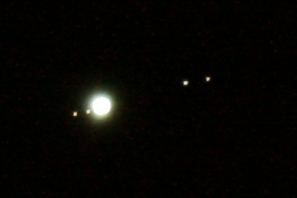Jupiter is making its closest 2008 approach to Earth tonight. Last night I aimed my 300mm telephoto (480mm film equivalent) in the direction of the Jovian system, and captured the planet with four of its largest moons:

One of these days, I'll mate my camera to a telescope, and then I'll be a "real" amateur astrophotographer. In the meantime, I was surprised what could be done with a simple tripod and camera.



3 comments:
That's really cool! :)
That is pretty impressive! Wow!
I'm planning to post a "how it was done" blog entry with more details, but here is a short answer to the exposure question:
1/2 sec, f/5.6, ISO-800
To avoid overexposure of Jupiter's disk, I found this setting to work:
1/30 sec, f/16, ISO-800
I'll show the results of that shot in the above-mentioned upcoming blog posting. It isn't very exciting; the resolution is not high enough to show any surface features.
Of course, I bracket my exposures and pick the best ones afterwards.
Note: With my maximum zoom (300/480mm), the slowest practical shutter speed is 1/2 second, below which the earth's rotation causes star-trails.
By the way, tonight (July 10), Mars and Saturn will have their closest conjunction for the next 14 years; they will be just 0.25 degrees apart in the west, shortly after sunset.
Post a Comment